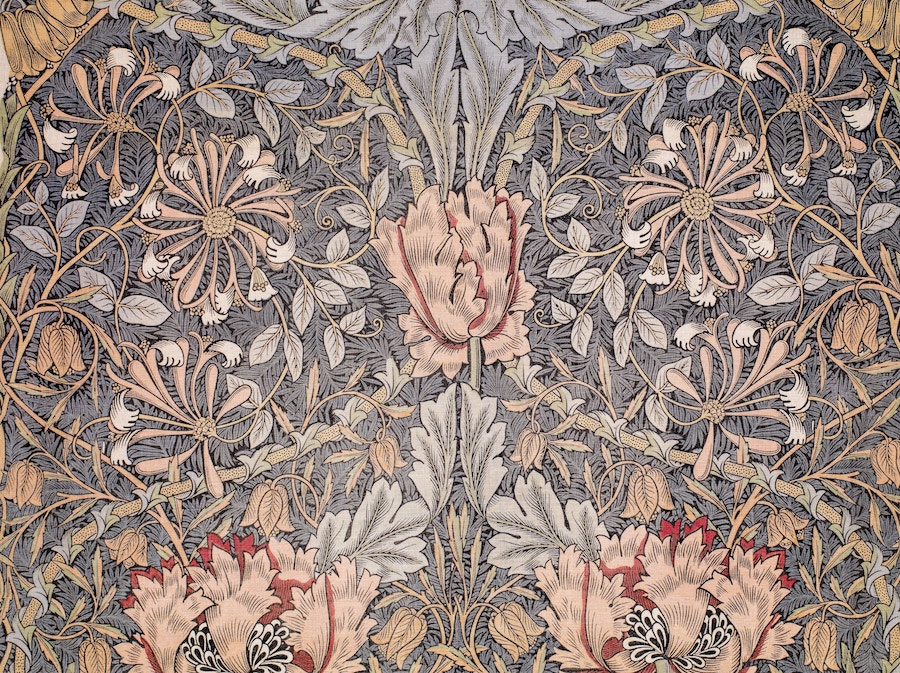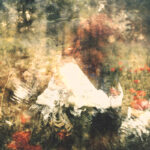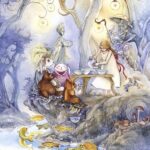Dear fellow fairytale lovers & readers,
This is part of my series “The Story Threads” where I discuss the esoteric symbology and layers of wisdom found in famous tales, lore and myth, and how it all relates to our current times and the evolution of our consciousness. Previous posts in these series include What Donkeyskin Knows, What Cinderella Knows, What The Snow Queen Knows, What Sleeping Beauty Knows, What Rapunzel Knows, Wild Marriage, The Gift of the Magi, The Dandelion Girl, What Snow White Knows, Beauty and Her Beast, Weaving Life, Bluebeard, Étaín, and many more that you can find in my folklore + myth section.
It was dark inside the wolf,
almost as dark as inside the human suit
… or what some others call, the tale of Little Red Riding Hood. This is one of the most loved and read children’s fairytale of all time, and yet few people know that the original story was actually told in the French countryside long before Charles Perrault published his written version in 1697. The oral version called The Grandmother’s Tale had its roots in ancient Asian stories, though it was largely shaped by the folk traditions of rural France from the Middle Ages onward.
As a child, I have to admit, I never really liked this tale as much as perhaps others did; mainly because I felt so sad for the wolf as I love animals – including wolves, jaguars and leopards, who are my favourite. And so I wasn’t feeling excited to write about it; I didn’t even think I’d have much to work with anyway because it seems “simplistic” and I thought it wouldn’t be much stimulating to my mind anyway. But then I remembered how I wasn’t excited about Snow White neither, and yet the more I delved into it for my essay, the more I actually grew to deeply appreciate it and learned so much from it. As all else in life – the more we spend time with something, the more we appreciate it, and we can only love what we appreciate.
Little Red Riding Hood is what is known as one of the big fours in fairytales, the others being Snow White, Cinderella, and Sleeping Beauty, all of which I’ve written previously about. These four are essentially told and retold in many versions throughout the world, and throughout history, as their roots are in folk traditions and oral tales from which many other tales were, and are, born – and this makes them important to study. And they also hold importance because of their reflections on societal issues during those times and have great historical culture significance.
So as part of my Story Threads series, I wanted to revisit Little Red Riding Hood and unfold its layers. Turns out, it is a story of much complexity and layers of wisdom, and as most other stories that I’ve covered so far, it is yet another one that reflects female initiation and maturation. Perrault’s Little Red Riding Hood was essentially a gentle caution to children and youth against trusting men; because some wolves have walked out the forest to become charming Parisian men only to take advantage of the innocence of girls. Before we go into all of the layers of this tale, its analysis and cultural significance, let’s first begin with its beginning, The Grandmother’s Tale.

Illustration by Lisbeth Zwerger
The Grandmother’s Tale: The Path of Pins or Needles
There are many versions of it, as it was an oral tale, but in general the story goes like this:
A woman finished her baking, so she asked her daughter to take a fresh galette and a pot of cream to her grandmother who lived in a cottage deep into the forest. The girl set off, and on her way she met a bzou (a werewolf).
“Where are you going? What are you carrying?” asked the bzou.
“I’m going to my grandmother’s house to bring her some bread and cream,” said the girl.
“Which path will you take – the path of needles or the path of pins?
“I’ll take the path of pins,” said the girl.
“Very well then. I’ll take the path of needles, and we’ll see who gets to the house first.”
The girl set off, the bzou set off, and when he got there first, he ate the grandmother, put on her clothes and slipped into the bed in disguise.
When the girl arrived, the bzou told her to put the bread and cream in the pantry, come into bed with him,
“Take off your shoes, my dear girl. Good, now, take off your coat, and dress, and shirt, and come into bed to cuddle up together and be warm.”
As the girl did as told, and came closer to the bed, she suddenly recognized that this was the bzou, and so she used her wits and said, “I’ll come into bed, but I must go outside for a while, dear grandmother.”
“Okay, my child,” said the bzou, “but hurry and come back. And because I am worried about you, I’ll tie a little woolen thread to your ankle, so that you don’t get lost in the darkness, or even worse, get eaten by the bad wolves outside.”


Illustration by Lisbeth Zwerger
When the girl went outside, she immediate cut the thread with the scissors in her pocket, and tied it to a plum tree.
When the bzou called for the girl, she didn’t answer, so he ran outside to chase her. Hearing him behind her, the girl ran to the river bank that her grandmother had once told her about; and there were the wise women laundresses.
To help her cross, they spread a white cloth sheet over the water, holding it tightly by its ends, and the girl used it as a bridge to escape.
When the bzou came, he asked for the same to be done, but when he was half way across, the women dropped the cloth, he fell into the waters and drowned.
Numerous variants of The Grandmother’s Tale were collected by French folklorists in the 19th and 20th centuries in the Loire basin, the Nivernais, the Forez, the Velay, the northern Alps, and the Italian Tyrol. Italo Calvino published a version from Abruzzo in his collection Italian Folktales (1956), and called it The False Grandmother. In his story a hungry ogress takes the place of the wolf – but in other respects, the story is quite similar to the French folktale. Then of course there is Charles Perrault’s tale Little Red Riding Hood (1697) where we see the introduction of the red hood; and in the Brother’s Grimm tale, we also see the hunter who helps the girl escape the wolf.

Illustration by Daniel Egnéus
The Path of Needles or the Path of Pins
In the oral folk tales the girl has to choose between the path of needles or the path of pins; in some versions, she choose the needles, and in others, the pins. Folklore scholars have different theories on what precisely these paths were meant to represent. Sewing and spinning are often terms we find in fairytales, lore and myth, and these have a long history of mysticism and esoteric meaning. One such is that they represent the spinning of the wheels of life, and the sewing of our own cloths – of the choices we make each day through our efforts, words and actions, that eventually pave our paths forward. There is a patience and kindness of rhythm in weaving and spinning that reminds us to do the same, and there is devotion, dedication and discipline that such tasks require, which are also virtues for our own lives. You can read all about that in my articles, The Secret Threads, and Weaving Life: Spindle, Shuttle and Needle.
Spinning and sewing were also big parts of women’s lives and labour prior to the 20th century; and these were often done in communities, in spinning rooms or tents, and around the evening fires. The women would gather together and tell many tales to each other, while also relieving their own worries and share in their emotions, which also created a space of women belonging. Spinning also means storytelling, as we spin words and stories together to reflect life’s moments. Words themselves are like mini Gods and they carry magic within them, which is why the way we speak and using a beautiful language is so important for our wellbeing, and used in manifestation and healing modalities also.
In many ways, spinning and weaving also represented the life of wise women, intuitives, healers and herbalists that lived into the forests, or in some privacy away from the “mainstream”, because they carried the wisdoms of the lineage and the mysteries of life. So in the tale, this is what the grandmother symbolized as well – and the girl initiates herself through the wisdom being handed to her.
Esoterically, pins and needles refer to the masculine and the feminine powers. Pins refer to the masculine aspect of initiation and energy, as it symbolizes the fire one directional force, and the male organ; while the needle represents the feminine organs, and its receptive power of entering the channel of God creation. Essentially, both offer a rite of passage.
And/also both referred to a woman’s rite of passage into maturation. Studying the folklore, traditions, and rituals of rural women in remote areas of France, we find that in many of the villages during that time girls at puberty would be sent off to spend a winter with local seamstresses – this passage of time marked a girl’s change from child to young woman.
This almost apprenticeship had less to do with learning to “work”, to sew and use needles, and was mainly about learning to refine yourself, polish yourself, learn patience and devotion, and learn to dress up and self-adorn. The seamstresses would often say of their apprentices as, “They have been here this winter gathering pins.”
Along with their winter time with the seamstresses, the girls would also enter a consecrated ceremony to Saint Catherine to signify their arrival at maidenhood (la vie de jeune fille).
La vie de jeune fille was essentially their permission to go dancing and have sweethearts, of which the pin was a symbol. It was by offering the girls dozens of pins that boys formerly paid court to girls; it was by throwing pins into fountains that girls assured themselves a sweetheart.
While pins marked the path of maidenhood or the ability to now have a man and a sweetheart, needles implied sexual maturity as we already discussed with their reference to the female sexual organs. The eye of the needle, in the folklore of seamstresses, symbolized the male penetration into the woman and the creation of pleasure or something “new” woven. In some parts of Europe, courtesans once wore needles on their sleeves.
But this eye of needle is so much more than that: as sexual energy for women is essentially our creation energy, we continuously create and weave something new, whether it is meals, books, poetry, music, gardening – we make love continuously. This is the magic woven – out of love and intention, something new is born always.

Illustration by Daniel Egnéus
The wolf represented the appetites we have – all kinds of appetites, including not only the foods and sweets, but our sexual desires also. The use of the colour red emphasizes this even more, as red is the colour of desire, passion, our root chakra, sexuality, and also safety, stability, fear, anger, and all else related to our primal needs for life and survival. Though focusing on those aspects of the tale that speak the language of female initiation, we see how important of a role the wolf actually plays. The wolf isn’t only about the temptation, desire, and the dangers of seduction, but he is also an agent of change and the catalyst for spiritual transformation.
In the Native American Cherokee teachings about life, it is said that we all have two wolves inside of us: one white and one black.
There are many interpretations, but my own perspective is that It isn’t about starving one and killing it, it is about learning the balance and disciplining ourselves. It is about knowing which one to feed, yes, and yet not to let the other starve or ignore him because he’ll become a beast and eventually eats us up unconsciously. We all have appetites, we all have powerful emotions, and each emotion itself has its own purpose and way of language. If we understand it, and hear it, by taming it with patience, discipline and kindness, it will tame itself and speak to us, and it might even become our ally in life.
So for example: anger. It is red. But it is also where passion and motivation can come from also. It is a sign that perhaps something has crossed our boundaries, or that we have suppressed a sadness or injustice or grief for too long and it has now changed shape to become anger. At its root sometimes is actually fear or a time when we felt powerless. It can have many messages, and if we hear them properly and know how to channel this energy healthily, it will become the fires that warm and feed us food, rather than the fires that burn our house and destroy all around us.
Fear too can have many messages. It is red also. And it can become a powerful ally for us when we are in forest because it can warn us of danger coming close, or not to be too trusting. It can be of course very irrational and lead us astray, and the result of our own previous experiences, suppressed patterns, unhealed wounds and limiting thought structures. The point is: know thyself.
Sexual power is a great power for every woman but she should learn to harness it, otherwise it gets dark inside the human suit. A woman needs to know that each time she is intimate with a man, his energy absorbs into hers, and this will affect her on many levels regarding her wellbeing. Choosing the right partner for you is one of the most important decisions you’ll make in life, so choose wisely. Having multiple sexual partners creates disturbances in the aura as well, and people who watch a lot of porn usually develop what looks like little dark worms in their aura. Tame your appetites, while taking care of them and giving yourself the pleasure you need. You shouldn’t suppress your sexual pleasures, but you shouldn’t fall submissive to them neither.
When we own up all of our different aspects of ourselves, we integrate ourselves into wholeness, and thus it is harder for other people to manipulate and control us – because we know ourselves more wholly, and it is harder to someone to take advantage of or manipulate us through our insecurities, fears and vulnerabilities.
Let’s look at the tale within a historical context, for it was published in 1697 for a very particular audience: aristocratic readers in the court of Louis XIV. The Sun King’s court was famed for its wealth, its intrigues, and its sexual excesses, particularly as practiced at the King’s sumptuous playground of Versailles. At the same time, virginity in young brides was absolutely insisted upon, because marriage was a business arrangement contracted between two families, and a girl’s market value decreased sharply if her virginity was compromised. Perrault’s story addressed the subject of seduction and rape. What “rape” was defined as during those times was any instance in which a man would take a woman without the consent of her father, regardless of whether or not she wanted it. So if a woman was in love with a man and wanted to marry him, but her father didn’t agree, that’d be rape. If she didn’t want to, yet her father agreed to the arrangement, any sexual intercourse no matter how brutal, forced or unwanted, would not be rape.
This is because during that time in France, fathers had almost ownership over their daughters, and the absolute legal to right to determine whom their daughters would marry. Any man who seduced or married a young woman without her father’s consent was guilty of rape, regardless of the woman’s wishes. To avoid this occurrence, daughters were often kept locked in convents until they married in order to avoid romances and elopements. Perrault’s own wife had been raised in a convent, emerging shortly before their marriage, and Perrault had only seen her once before the actual wedding.

Illustration by Gina Litherland
At the same time more women were beginning to rebel against this and seek their sexual and romantic freedom, particularly the influencial women who hosted the French salons. The salong were basically clubs where women of status would mix with men, as they all gathered to exchange intellectual ideas, and many famous women authors were part of those salons also. It is in the French salons where fairytales were born, as these were tales initially written for adults, not children, to raise awareness on various socio-economical and political issues.
Within the salons, men and women could mix more casually than was possible at court; they could converse about art and politics, and meet on more equal terms. Perrault himself was a frequent visitor to the salons, and as an intellectual, he often championed modern culture, which was generally more favorable to women. Having said that, he still had to keep his heroines bien faites and gentilles, i.e. good girls not rocking the boat too much, because of his royal court audience.
Some people believe that Perrault’s version of the tale was a warning to the French salon women not to mix with men who might destroy their reputation and to be mindful of their own personal temptations when they mix with the men from the salons. His wolf was perceived as the charmer of the Parisian high class society, the seducer of young beautiful educated women, and a threat to the family patrimony. Some argue that Perrault’s wolf is the “unsuitable suitor” who charms his way into the best beds in town, deflowering women, and robbing them of their virginal values.
In Perrault’s words, which I personally believe to have been his true intentions especially considering that he had children and loved them dearly, his tale was to gently caution his darling girls against being too trusting with men, as “the seemingly tamed wolves were often the most dangerous ones.” His message was also to caution all children and youth against older men being predatory and to be watchful when they walk the streets of Paris.
Perrault began writing fairytales at the age of 67, when he decided to be fully dedicated to his children and their care. Inspired by them he wrote beautiful tales, and at each tale’s end he’d include a moral, like a personal message to all children. I find this beautiful, sweet and inspiring; so I don’t agree with some critics out there saying that he was some anti-feminist or a slave to the patriarchal agendas. And I personally greatly appreciated his message at the end of Sleeping Beauty that it’s best a lady waits a hundred years than kiss a fool.
In a modern day context, because we aren’t living in 17th century France anymore, this tale doesn’t mean we have to go to convents or stay virgin until marriage if that’s not what we want – and there is nothing wrong with our sexual needs, but it means to have our wits, practice discernment, and know our worth.
Beware of the charming suitors who show up with all fancy words and promises and sparkling chalices on your porches and front doors, because for all we know, it could be dark inside the human suit.
There is nothing romantic about having a relationship with a Bluebeard. And Joe Goldberg from Netflix’ You isn’t the kind of man you want to be loved by neither, despite his charm and perhaps physical appeal.
Little Red Riding Hood has been told and retold for many years, and will continue to be; it has been changed in many curious ways, though sometimes diminished or even punished for its narrative or naive silly nature. I think it’s important to know and retell its older versions also.
Because every time we are doing that, we are reclaiming and honouring the spirits of the many girls and women who faced wolves in their lives and were able to outwit them – wolves not only of those walking externally, but those who walk our own inner wildlands also.

For more of my writings, browse through my Art of Love.
If you wish to support me and my work, you may do so by sharing it or donate here. For personal readings with me, you may visit my Offerings.
Your support means so much to me! Thank you wholeheartedly!
Cover art: Birmingham Museums Trust. Source: Unsplash.




